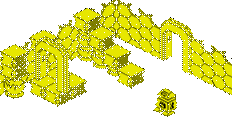






 |
 Connectors Connectors
- Cartridge slot - top-loading (62-pin, although most cartridges only connect to the middle 46 pins)
- "Multi Out" 12-pin A/V connector for composite/RGB/S-Video connection, or RF with an external RF modulator (Multi Out port also used later on N64 and Game Cube)
- Two game controller connectors (proprietary 7-pin)
- Expansion slot (28-pin) on bottom of console
- DC power socket - 10V @ 850 mA. Negative center, positive on outside.
 Technical Facts Technical Facts
- Individual game cartridges for the Super NES can include further custom chips as needed to enhance the console's standard capabilities.
- The Super NES' CPU is a Nintendo-custom 5A22 processor, based on a 16-bit Western Digital 65c816 CPU core.
- The PPU (Picture Processing Unit) used in the Super NES consists of two seperate but closely tied IC packages, which may be considered as a single entity. Both NTSC and PAL systems use the same PPU chips, with one pin per chip selecting NTSC or PAL operation.
- Sprites can be 8×8, 16×16, 32×32, or 64×64 pixels, each using one of eight 16-color palettes and tiles from one of two blocks of 256 in VRAM. Sprites may be flipped horizontally and vertically as a whole. Up to 32 sprites and 34 8 × 8 sprite tiles may appear on any one line.
- There are 8 video modes supported by the Super NES; each mode supports a different number of layers with varying palette support. Mode 0 supports the maximum number of 4 layers, all using 4-colour palettes. Mode 1 supports 3 layers, of which two can support 16-colour palettes. Modes 2-5 are 2-layer modes, supporting from a single 256-colour palette down to 2 16-colour palettes. Mode 7 is rather special in that it supports a single layer of 128x128 tiles from a set of 256 - think of this as a single 256-colour 1-plane layer or a 128-colour 2-plane layer. The layer can be rotated and scaled using matrix transformations.
- Cartridges were shaped differently for different regions. This basic level of 'regional lockout' was easily overcome by modifying the console or through the use of various cartridge adapters.
- A regional lockout chip (CIC) was incorporated into the Super NES, and also into each cartridge. This prevents PAL region games from being played on an NTSC console, and vice versa. Japanese and North American consoles have the same CIC chip. Adapters were produced by third parties to overcome these restrictions, which typically involved inserting the import cartridge into one slot and a cartridge with the correct region in a second slot on the adaper.
- CIC chip variants include D411, D411A, D411B, F411A, D413, D413A, D413B and F413A.
- The SNES controller differs from the NES controller by adding two shoulder buttons and two more face buttons making 4 in total arranged in a diamond formation.
- As part of the overall plan for the SNES, rather than include an expensive CPU that would become obsolete in a few years, the hardware designers made it easy to interface special coprocessor chips to the console (just like the MMC chips used for most NES games). This is most often characterized by 16 additional pins on the cartridge card edge. One such enhancement is the Super FX, a RISC CPU designed to perform functions that the main CPU could not feasibly do. The chip was primarily used to create 3D game worlds made with polygons, texture mapping and light source shading. The chip could also be used to enhance 2D games. Star Fox was the first game to utilize the Super FX chip.
 Trivia Trivia
- Game cartridges can contain a battery-backed SRAM to save the game state, or extra RAM, custom coprocessors, or any other hardware as long as it doesn't exceed the maximum current rating of the console.
-
|
| |
|
|
 Connectors
Connectors  Technical Facts
Technical Facts Trivia
Trivia








